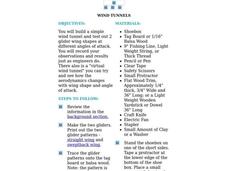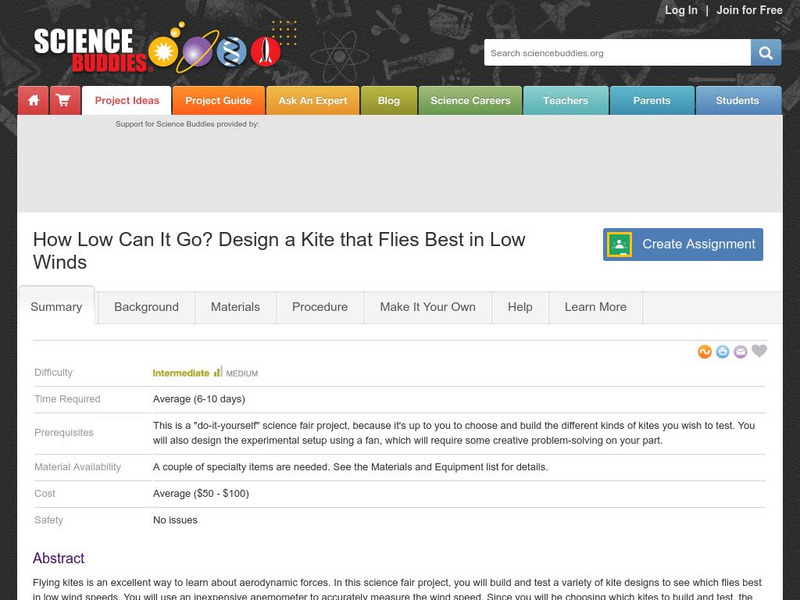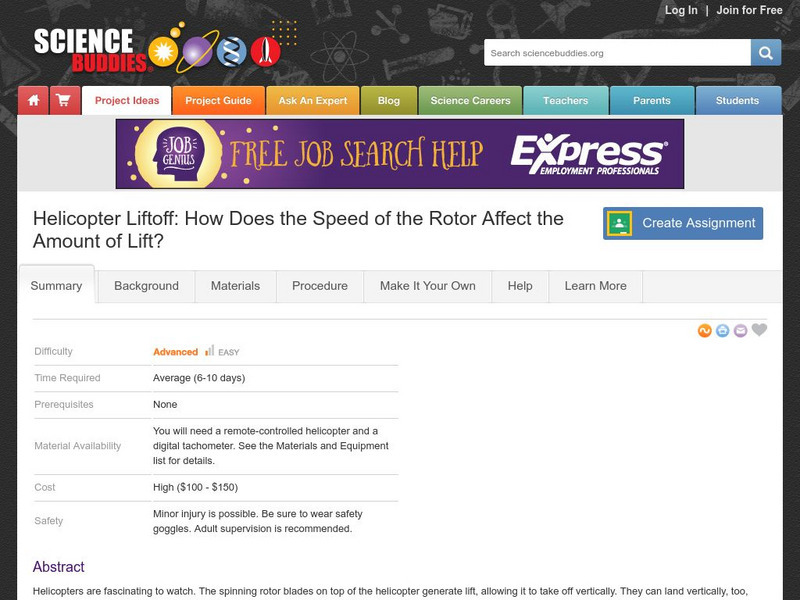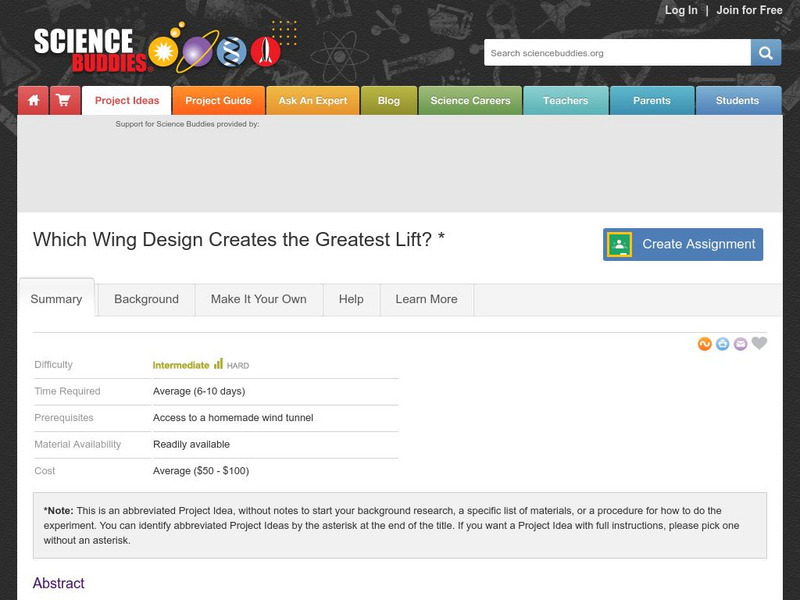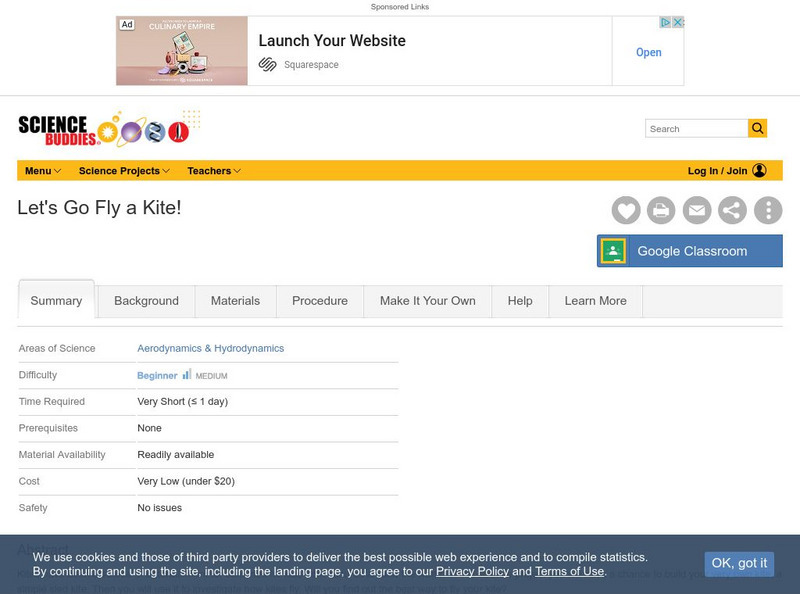Curated OER
Wind Tunnels
Students build a simple wind tunnel and test out 2 glider wing shapes at different angles of attack. They record their observations and results just as engineers do. There also is a "virtual wind tunnel" they can try to test aerodynamic...
Curated OER
Aerodynamics of Cycling
High schoolers study aerodynamic forces - lift and drag - and see how those forces affect cycling performance. They see how those forces are calculated and how
Curated OER
Aerodynamics of a Boomerang
Students examine how aerodynamic forces affect the flight of aircraft, animals and sports balls and projectiles (like a javelin or boomerang). They discover the origins of the boomerang and early usage in hunting.
Curated OER
Airspeed Problem Set
Students demonstrate an understanding of aircraft launch airspeed requirements. They read a selection on relative velocities from a NASA Web-based textbook, then calculate airspeed launch requirement problems.
Curated OER
Wing Area Effects Problem Set
High schoolers read an explanation from a NASA Web-based textbook on lift and an explanation on the FoilSim software package given below. They use FoilSim to evaluate the relationship between wing area and lift.
Curated OER
Velocity Effects Problem Set
Students, after reading an explanation on lift from a NASA Web-based textbook and an explanation on the FoilSim software package given below, use FoilSim to evaluate the relationship between velocity and lift.
Curated OER
Equation of State Problem Set
Learners demonstrate their understanding of the equation of state by computing the gas constant from air properties. They use online research tools and apply integrated math problem-solving strategies to solve problems outside the realm...
Curated OER
Why Invent That?
Students demonstrate an understanding of the text by completing an activity on the advantages and disadvantages of inventing and using a human-powered airplane.
Curated OER
Displacement Problem Set
Students calculate the length of a side of a triangle using a trigonometric function. They calculate the measure of an angle given two sides of a triangle with a trigonometric function.
Curated OER
Mach Number Problem Set
Students read a textbook about aerodynamics. They find out the definition of Mach number. They complete problems designed to demonstrate their ability to solve Mach number equations.
PBS
Pbs Learning Media: Aerodynamics: What Causes Lift?
How does an airplane stay aloft when upside down? This media-rich essay from the NOVA Web site offers an explanation based on Newton's third law of motion.
Science Buddies
Science Buddies: Project Ideas: Design a Kite That Flies Best in Low Winds
In this science fair project, use a fan and an anemometer to test various kite designs to see which will fly best in low wind speed. The Science Buddies project ideas are set up consistently beginning with an abstract, objective, and...
Science Buddies
Science Buddies: Project Ideas: Helicopter Liftoff: Rotor Speed Affect on Lift
In this science fair project, measure the rate of rotation of a remote-controlled helicopter rotor, using a digital tachometer, and relate this to the lift the blade generates. The Science Buddies project ideas are set up consistently...
Science Buddies
Science Buddies: Why Do Birds Fly in a v Formation?
In this science fair project, the student will make a wind tunnel to test how the formation of birds in flight affects flight efficiency. Make the bird models out of Legos and have fun with this project. The Science Buddies project ideas...
Science Buddies
Science Buddies: Model Rockets Aerodynamics: Stability
This science fair project for Science Buddies lets you be the rocket scientist. See how the rocket design changes its performance. The Science Buddies project ideas are set up consistently beginning with an abstract, objective, and...
Science Buddies
Science Buddies: Which Wing Design Creates the Greatest Lift?
Airplane wings do not all have the same design. With this Science Buddies project you can design your own wings to see which offers the greatest lift. The Science Buddies project ideas are set up consistently beginning with an abstract,...
Science Buddies
Science Buddies: The Wright Stuff: Using Kites to Study Aerodynamics
If you are interested in aerodynamics, wait for a windy day and go fly a kite. This Science Buddies project gives you many ideas to investigate as experiment with shape, size, and ways to fly the kite. The Science Buddies project ideas...
Science Buddies
Science Buddies: The 'Ultimate' Science Fair Project: Flying Disk Aerodynamics
Tossing a Frisbee with your friends is a great way to have fun in the sun. As you practice your throws and become more accurate, you're learning about the aerodynamics of Frisbee flight intuitively. You're learning the body mechanics...
Science Buddies
Science Buddies: Why Do Aerobie Flying Rings Go So Much Further Than Frisbees?
Use the instructions from this Science Buddies project to develop your hypothesis on whether flying rings fly farther than flying disks. The Science Buddies project ideas are set up consistently beginning with an abstract, objective, and...
Science Buddies
Science Buddies: Winglets in Wind Tunnels
Have you noticed the little wing projections on the wings of jets? This Science Buddies project helps you understand whether these fins help stabilize airplanes. The Science Buddies project ideas are set up consistently beginning with an...
Science Buddies
Science Buddies: Why Winglets?
Make a paper airplane and experiment with adding winglets to it to test its performance. The Science Buddies project ideas are set up consistently beginning with an abstract, objective, and introduction, followed by a section on terms,...
Science Buddies
Science Buddies: How Much Weight Can Your Boat Float?
Have you ever wondered how a ship made of steel can float? In this project you'll investigate how much weight boat hulls of various shapes and sizes can support without sinking.
Science Buddies
Science Buddies: Project Ideas: Whirl Y Bird vs. Whale Y Bird
Improve the design of a very simple aircraft, the whirlybird, and learn about hydrodynamics and biomimicry in this science experiment. The Science Buddies project ideas are set up consistently beginning with an abstract, objective, and...
Science Buddies
Science Buddies: Let's Go Fly a Kite!
By making a simple sled kite from the template provided and using the suggestions in the Science Buddies project, you can experiment with variables that test different aspects of flight. The Science Buddies project ideas are set up...


